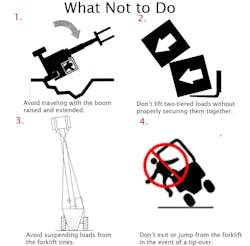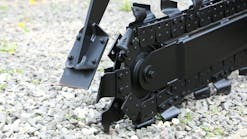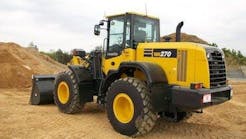As common as forklifts are, operating one is nothing like driving a car. It is essentially a balancing act that requires utmost skill, training and attention. According to the Occupational Safety and Health Administration, 85 fatal forklift-related accidents occur each year. Another 34,900 operators suffer serious injuries. Forty-two percent of those deaths are a result of operators crushed by the forklift after an unintended tip over.
Without training, operators adopt bad habits from each other, says Jeff Stachowiak, director of safety training at Sunbelt Rentals. This leads to maneuvers, lifts and other operating actions that appear safe, but may result in a catastrophic forklift failure.
Know what you're lifting
One important skill that operators should have is to be able to estimate the weight of each load. In heavy construction, loads often have a known weight, which is listed on the load itself. An eight-inch concrete block, for instance, weighs around 35 pounds. Operators pick up cubes containing 90 concrete blocks, adding up to approximately 3,000 pounds. If the blocks are wet, they may weigh another 100 or 200 pounds.
“Every forklift is made to the same ANSI/ASME standard,” Stachowiak says. “All forklifts are designed to pick up a 48-inch by 48-inch by 48-inch cube with the load laterally centered 24 inches out and up.”
“Anytime you’re picking up a load outside that 24-inch load center, unless it’s indicated on the I.D. plate or the load chart, it’s really an unknown capacity,” he says.
If operators don’t know the weight of a load, they should ask their supervisor for it.
“The load must be split or a machine of sufficient capacity should be used,” says Mike Pankonin, senior director of technical and safety services for the Association of Equipment Manufacturers. “If there is any question about the weight of the load or the capacity of the machine, the load should not be moved.”
“You have to look at the load chart and you have to look at where you’re going to place the load,” Stachowiak says. “You have to figure out whether you’re within capacity on the load chart.”
Many operators, however, use “the seat of their pants” to determine the weight of the load and whether the forklift can handle it.
Operators, for example, commonly do not pull up close enough to a building to place or lift a load using an extended boom. They end up tipping the forklift because they decline to use the load chart.
Anytime the rear wheels come off the ground, the limitations of the forklift have been exceeded and therefore an accident has occurred, Stachowiak says, even if the machine doesn’t tip over. The forklift may appear intact, but the rear axle could have been damaged after hitting the ground.
Other times, forklifts tip when not loaded.
“Driving without out a load, that’s when the machine is least stable,” Stachowiak says. “All of the center of gravity is closer to the rear of the machine, and putting a load on the forks actually stabilizes the forklift.
Tipping an unloaded forklift often happens when an operator has just placed a load on scaffolding using an extended boom. Rather than using the joysticks to retract and lower the fork, the operator puts the entire machine in reverse and turns abruptly while bringing the boom down, which pushes the center of gravity to the edges of the forklift.
“At that point, it’s not hard to tip the forklift over,” he says.
Regular maintenance
As for maintenance, fleets often overlook forklift brakes. Part of an operator’s pre-start check must include simple brakes testing to determine whether they work both forward and backward. Emergency brakes should be checked regularly as well. Just like with a car, if the brakes feel mushy or lack stopping power, the operator needs to alert the service department.
“There’s a huge amount of forklifts out there that don’t have working brakes on them,” Stachowiak says. “The way operators stop without brakes is by shifting between forward and neutral, or they drive into the load and it stops when it hits the pallet.”
Forklifts engage in rigorous work requiring heavy loads to be raised and lowered several times each day. Combined with tight work schedules that contractors must stick to, operators push forklifts to their limits.
Get to know the limits of each forklift you use by reading the operators manual and becoming familiar with its load chart.





